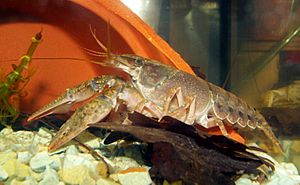Faxonius immunis facts for kids
Quick facts for kids Faxonius immunis |
|
|---|---|
 |
|
| Conservation status | |
| Scientific classification | |
| Genus: |
Faxonius
|
| Species: |
immunis
|
| Synonyms | |
|
|
Faxonius immunis is a species of crayfish in the family Cambaridae. It is native to North America and it is an introduced species in Europe, where it lives along the Upper Rhine. Its common names include calico crayfish and papershell crayfish.
Taxonomy
Faxonius immunis was first described by Hermann August Hagen in 1870, in his Monograph of the North American Astacidae, under the name Cambarus immunis. The original specimens came from Lawn Ridge, Marshall County, Illinois.
Description
Faxonius immunis is similar to a number of species of crayfish in the genus Faxonius. While the colouration of the claws is distinctive, it can be difficult to use that to identify a specimen without reference specimens for comparison. F. immunis can be distinguished from F. virilis by the presence of a notch near the base of the dactylus (finger) of the claw, which is not found in F. virilis.
Distribution and habitat
North America
Faxonius immunis naturally occurs across a wide area of eastern North America, from Maine and Connecticut in the east to Colorado and Wyoming in the west, and from Alabama in the south and north to Manitoba, Ontario and Quebec in Canada. Populations in Quebec may be the result of introductions by anglers from New York; the Canadian populations are centered in southern Ontario. It is believed to have been introduced to a number of states in New England, including Massachusetts, Maine, New Hampshire, Rhode Island and Vermont.
Europe
Faxonius immunis has been popular in the aquarium trade in Germany, and is kept as a pet both in aquaria and garden ponds. The first recorded escape was a single individual in a small canal in the Rhine valley of Baden-Württemberg in 1997. Later, a breeding population was discovered, and this has now spread at least as far downstream as Karlsruhe (45 km or 28 mi downstream) and possibly as far as Speyer (35 km or 22 mi downstream from Karlsruhe). It has since been recorded from other locations in Europe, including the German state of Rhineland-Palatinate, as well as in France. It appears to be out-competing another invasive species, F. limosus, which has been present in the area for five decades.
Habitat
Faxonius immunis is only found in slow-flowing bodies of water, such as streams, ponds, marshes and roadside ditches, in contrast to O. virilis which also lives in rivers with moderate flow. It can survive in areas with large fluctuations in the amount of available water, by burrowing into the ground when the surface waters recede.


